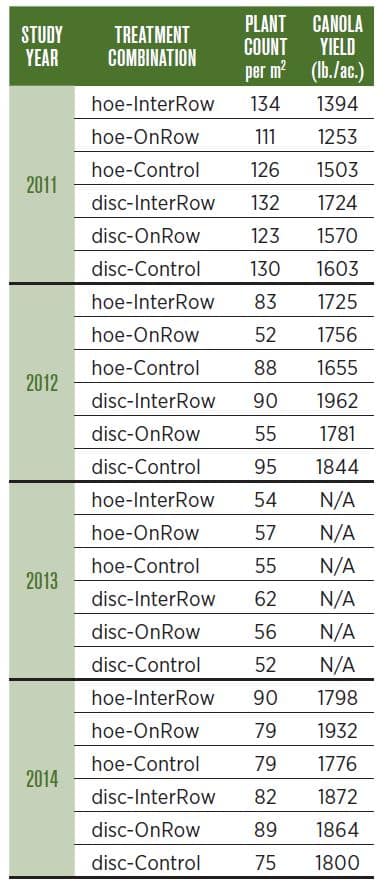Key Result
Seeding into bare soil between the previous year’s stubble rows will improve canola germination and plant establishment without increasing seed costs.
Project Summary
Highly accurate GPS guidance and automated steering have given producers the ability to seed between the stubble rows from previous crops. This practice may allow for improved canola emergence due to more accurate seed placement, improved seed to soil contact, improved micro-climate, higher soil temperatures and seedling protection from more standing stubble.
In previous studies, Farming Smarter found that seeding on-row significantly reduced plant stand establishment in canola compared to seeding between the row and check plots. Also, canola yield was significantly higher with Pillar Lasers disc/hoe openers compared to Stealth paired row, and canola yield was not affected by row placement.
This study continued some of this work, comparing two openers: Pillar Lasers disc and Stealth paired row hoe; and three seed row options: between the stubble (inter-row), directly on the stubble (on-row) and a control with no attempt to align with stubble.
The field trial was set up on large-size plots (approximately 50m x 1.93m) in the Dark Brown Soil Zone near Lethbridge, AB. The study used glyphosate-tolerant hybrids seeded at 5 lb./ac. and 1/2″ into no-till cereal stubble. Soil moisture was excellent each year.
Three years were taken to yield — 2011, 2012 and 2014 (2013 was lost to hail and flooding). Data was collected on the plant emergence and final plant stands, weed presence and abundance, soil temperatures, canopy closure, stubble heights and yield.
Results from these three years validated Farming Smarter’s previous findings that seeding on-row significantly reduced plant stand establishment in canola compared to seeding between the row and check plots.
The results showed that, on the average, seeding canola crop between stubble rows with Pillar Lasers disc hoe type seeding row openers produced the highest canola plant stand count and, therefore, would most likely benefit producers in establishing the healthiest and most profitable canola crop.
For this study, canola seeded with disc hoe openers produced significantly higher yields than the paired-row openers, especially when used for seeding between the stubble rows of the previous crop.
CONCLUSION
Based on the results, Farming Smarter concludes that producers with the ability to inter-row seed could adopt the practice to enhance plant stands and protect against yield loss. It would also allow for better germination without increasing seed costs. Future studies should include reduced seeding rates.
Does this investment increase profits? Advanced GPS signals such as real-time kinematic (RTK) and Omnistar give producers the precision accuracy to seed within 2.5 centimetres of their intended target. However the cost to upgrade from a basic WAAS signal is prohibitive without a proven return on investment.






